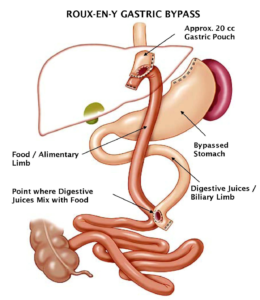 ROUX-EN-Y GASTRIC BYPASS
ROUX-EN-Y GASTRIC BYPASS
This procedure is both restrictive and malabsorptive. The surgeon converts the stomach to a small pouch that holds approximately 2 ounces of food. The gastric bypass procedure then routes food past most of the stomach and first part of the small intestine. In addition to restricting food intake, a Roux-en-Y gastric bypass reduces nutrient absorption.
This surgery limits the amount of food that can be eaten, yet leaves the patient feeling full and satisfied on very little food. Having less food naturally results in reduced caloric intake, and weight loss usually follows. With Roux-en-Y gastric bypass, risks for nutritional deficiencies are higher than restrictive procedures (bypass causes food to skip the duodenum, where most iron and calcium are absorbed).
WHY CHOOSE ROUX-EN-Y GASTRIC BYPASS
The procedure
- causes an early sense of fullness and satisfaction, thus reducing the desire to eat
- commonly results in greater weight loss
- requires less long-term maintenance relative to gastric banding (no band fills needed)
- reduces the chance to “cheat” the surgery compared with gastric banding

